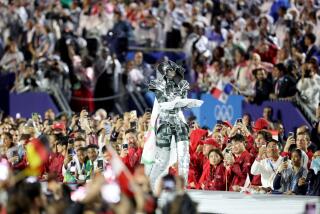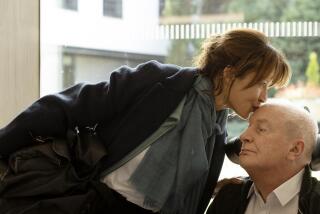Marcel Marceau, 84; legendary mime was his art’s standard-bearer for seven decades
- Share via
Marcel Marceau, the great French mime who for seven decades mastered silence and brought new life to an ancient art form, has died. He was 84. Marceau died Saturday in Paris, French news media reported, citing his former assistant Emmanuel Vacca. The cause of death was not disclosed.
On Sunday, French Prime Minister Francois Fillon praised Marceau as “the master,” saying he had the rare gift of “being able to communicate with each and every one beyond the barriers of language.”
Active until late in his life, Marceau toured the world for more than half a century, giving more than 15,000 performances. Each included several pieces featuring Bip, the beloved character he created early in his career. Annette Bercut Lust, author of “From the Greek Mimes to Marcel Marceau and Beyond,” said Marceau’s mentor, French mime master Etienne Decroux, “reinvented the art of mime to revive modern theater and the actor’s art,” whereas Marceau “popularized that art and brought it to the whole world.”
Starting as a child mimic of Charlie Chaplin, whose Little Tramp character in silent films made him laugh and cry, Marceau by the age of 30 had become the singular embodiment of the ancient art of mime. He also took mime in new directions.
One of the secrets of his success, some critics said, was Marceau’s ability to incorporate cinematic techniques into his stories.
He could, as former Los Angeles Times critic Dan Sullivan wrote, present a montage of fleeting moments that defined a character’s “age, sex, class, even clothing” that audiences who had been raised seeing the movies could easily follow.
Through the years, Marceau created dozens of adventures for Bip, the dreamy little poet whose white face, ill-fitting striped shirt, too-long pants and smashed hat topped with a jaunty red carnation are perhaps the most familiar image of mime today.
In addition to Bip’s adventures, Marceau also created many other “mimodramas,” including Gogol’s “The Overcoat,” the story of a Russian clerk who works for a decade to buy an overcoat, only to have it stolen. He performed innumerable solo sketches, such as “The Creation of the World” and, among his most revered works, one that showed the four stages of life -- youth, maturity, old age and death.
To be a mime, Marceau said, one must be a sculptor, a painter, a writer, a poet and a musician. And one must also have incredible physical stamina and talent. “It’s not dance,” he said. “It’s not slapstick. It is essence and restraint.”
The art of mime “is an art of metamorphosis,” he told a New York Times reporter some years ago. “It’s not stronger than words. You cannot say in mime what you can say better in words. You have to make a choice. Mime is beyond words. It is the art of the essential.”
Besides his performing, Marceau dedicated himself to being the muse for those who would follow him, including students who studied at L’Ecole Internationale de Mimodrame de Paris, which he opened in 1978. And he delighted in those who simply emulated him well, such as Michael Jackson, who developed his famed “moon walk” after seeing Marceau’s “walk against the wind” routine.
But Marceau also lamented that some of his less talented imitators had given mime a bad name. He especially rued the street mimes who worked popular tourist attractions such as San Francisco’s Fisherman’s Wharf.
“People think, ‘Oh my God, not again!’ when they see them and miss the fact that mime, done well, is like nothing else,” Marceau told the Los Angeles Times in 1989.
Though his art was mute, Marceau was a garrulous man offstage and never tired of recounting his life story or explaining the importance of mime -- hoping that he would not be the last to carry on its tradition.
The art’s roots stretch back to the Greeks 500 years before Christ. Centuries later, the Romans used pantomime to depict current events or mock the gods. Mime also had heydays during the Renaissance and with Jean Gaspard Deburau’s early 19th century clown character, Pierrot.
As the 20th century’s keeper of the art form, Marceau turned to his idol, Chaplin, as well as other silent-movie stars such as Buster Keaton, Laurel and Hardy, Harold Lloyd and Harry Langdon, and later Red Skelton, Jerry Lewis and others.
Marceau appeared in numerous films, most famously Mel Brooks’ “Silent Movie,” where as a joke he spoke the only word in the script: “No.”
Marceau was born Marcel Mangel, the son of a kosher butcher and his wife, on March 22, 1923, in Strasbourg, near the French-German border. The family moved to Lille and later to Limoges.
When the Germans invaded France during World War II, Marceau’s father was taken to Auschwitz, where he died in 1944. Marceau was 21.
Marcel and his older brother, Alain, changed the family name to Marceau -- after Francois Severin Marceau-Desgraviers, an 18th century French general -- and both brothers became part of the French underground.
Marceau found he had a talent for forging documents to help young Jewish men avoid the Nazi concentration camps, and he also helped spirit children across the border to neutral Switzerland. Toward the end of the war, he joined the Free French Forces, fighting alongside U.S. troops under Gen. George S. Patton.
It was before 3,000 of Patton’s soldiers that Marceau gave his first major performance, which was favorably reviewed by Stars and Stripes.
In 1946, Marceau began his studies in Paris at the School of Dramatic Art in the Sarah Bernhardt Theatre as a student of Charles Dullin. He hoped to become an actor, but when he encountered Decroux, who proclaimed him a “born mime,” Marceau changed his life’s course.
“I was good at it,” he told the Los Angeles Times in 1973. “And then it began to possess me.”
But Marceau soon departed from Decroux’s vision to codify in mime the movements of great dancers like Isadora Duncan as well as the movements captured in the statuary of Rodin and other sculptors.
Decroux “was strictly laboratoire,” Marceau told the Los Angeles Times in 1980, using the French word for laboratory. “I was theater.”
After initial success as Arlequin in the pantomime “Baptiste” from French actor Jean-Louis Barrault’s “Les Enfants du Paradis,” Marceau created his own “mimodrama,” “Praxitele and the Golden Fish.”
In 1947, Marceau created Bip, named after Dickens’ Pip in “Great Expectations” but also inspired by Chaplin and the clown Pierrot.
Marceau saw Bip as a Don Quixote character “who staggers with the windmills of life” and sent him on adventures ranging from taming a lion to getting stuck in an elevator.
Through the years, Marceau’s creations became deeper. He said he began by “hunting butterflies,” referring to one of his best-known mimes, and then later dug into misery, solitude and “the flight of human souls against robots.”
“I have spent more than half a lifetime trying to capture the tragic moment,” he told the L.A. Times in 1998. “I’ve matured, so has Bip, so have our audiences.”
His first appearance in the United States was in 1955 in New York City, where he was scheduled for a two-week run but got rave reviews and stayed on and, over the years, returned frequently.
Marceau said he continued with his heavy touring schedule because, unlike a singer, whose voice can be recorded and listened to on records, “mimes are masters of silence, soon forgotten if they don’t appear on stage regularly.”
He often told the tale of having encountered his idol, Chaplin, in an airport.
Chaplin, by then an old man, seemed to recognize his young adulator, so Marceau built up his nerve and went over to introduce himself.
He delighted Chaplin by doing a turn on the Little Tramp, and then Chaplin returned the flattery by imitating Marceau’s imitation.
When they parted, Marceau grabbed Chaplin’s hand and kissed it, which brought tears to Chaplin’s eyes.
By the age of 80, Marceau had cut back his traveling schedule from 300 performances a year to a mere 150 -- still a remarkable schedule for a performer of any age.
Though his face had become wrinkled and his hair gray, his compact body remained sinewy and his manner lively. His wordless routines continued to captivate audiences wherever he went.
“I would retire if the press said, ‘We have seen Marcel Marceau too much,’ ” he told the Associated Press in 2003 while on one of his many tours of the United States. “But now is when I’m having the best reviews.”
Funeral services are pending.
More to Read
The biggest entertainment stories
Get our big stories about Hollywood, film, television, music, arts, culture and more right in your inbox as soon as they publish.
You may occasionally receive promotional content from the Los Angeles Times.










